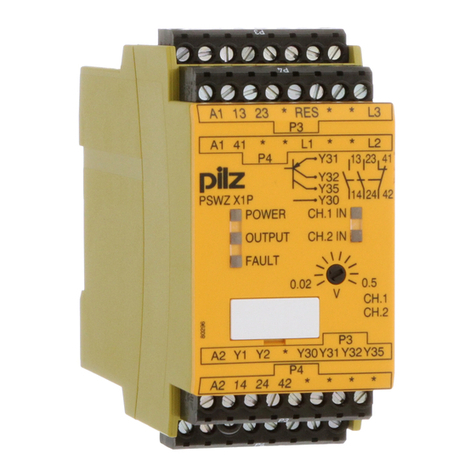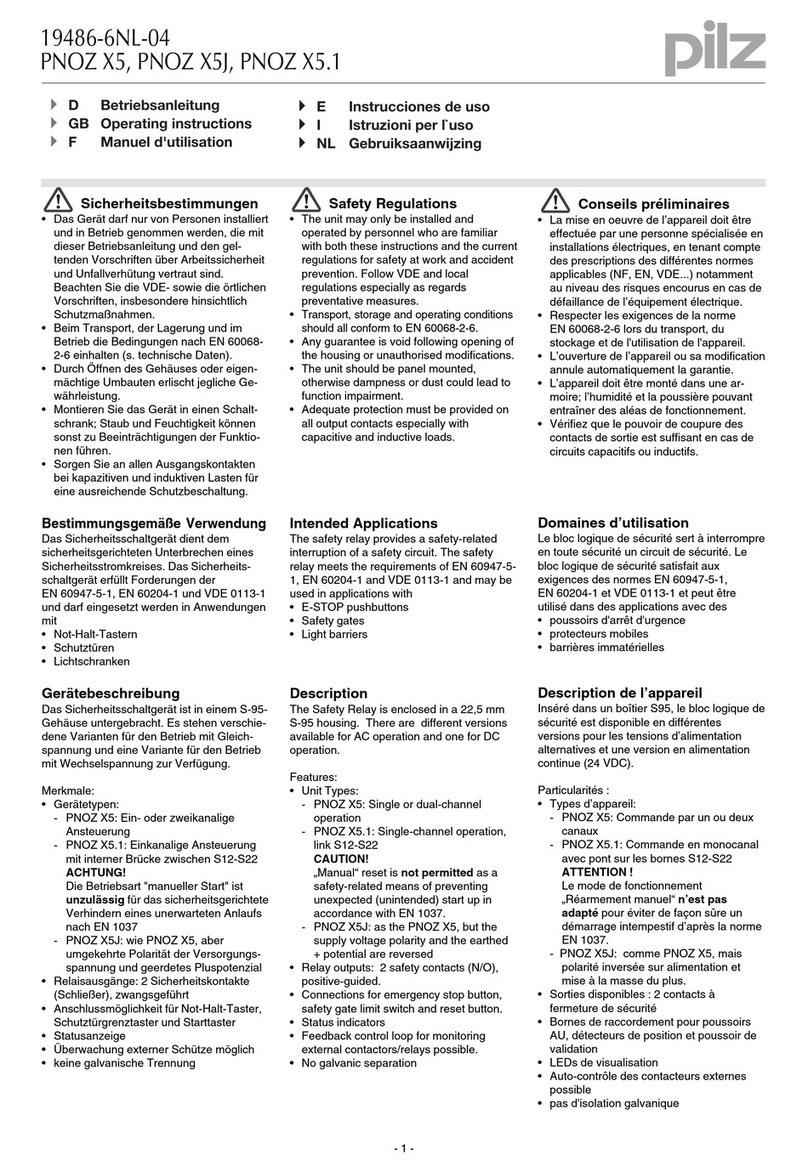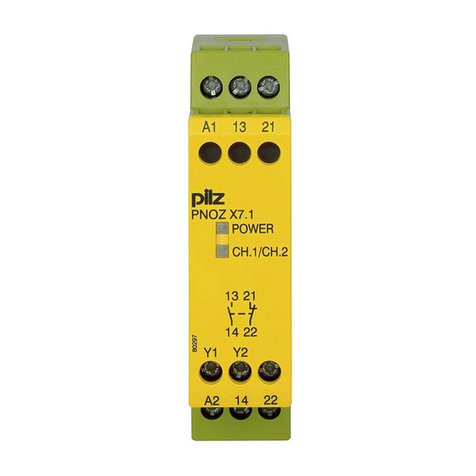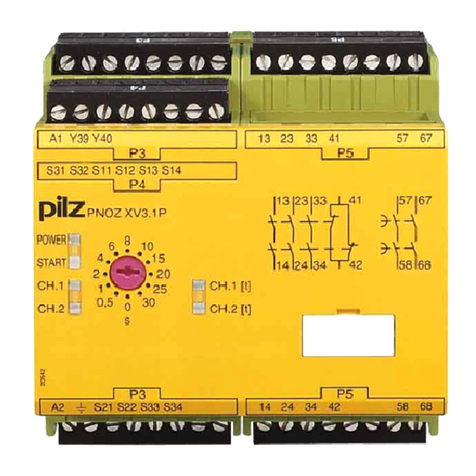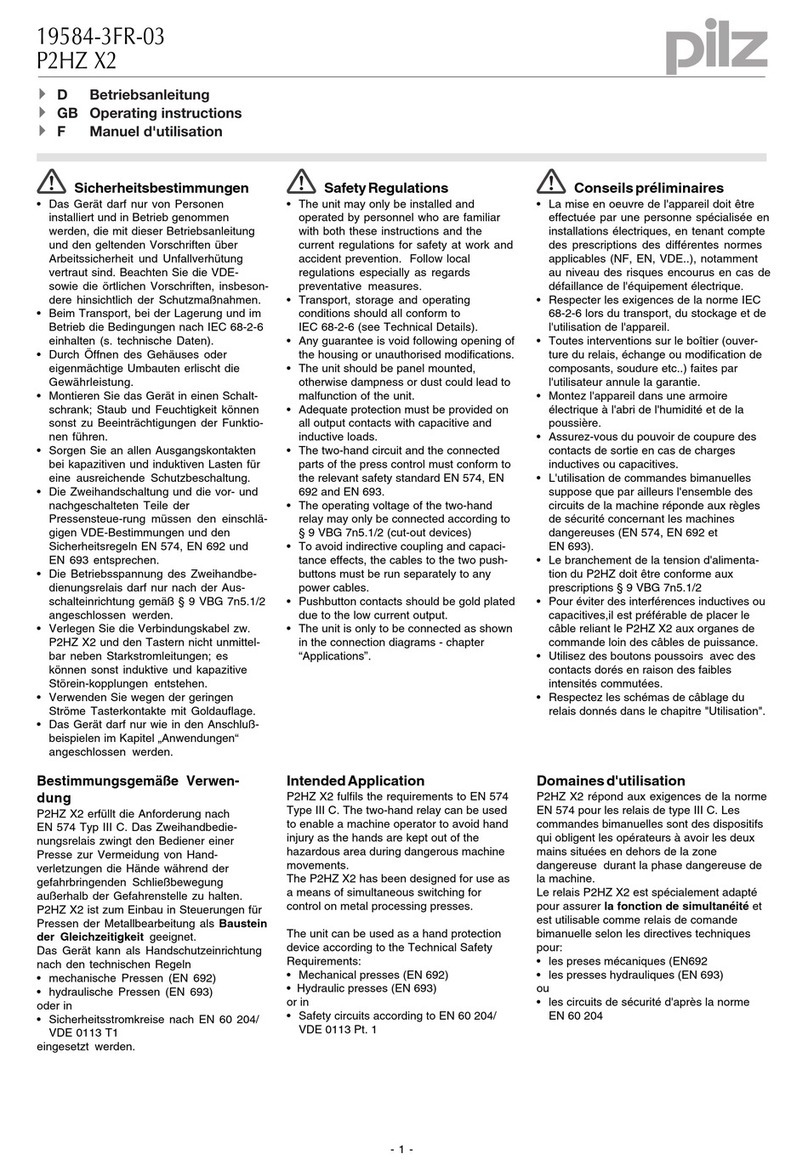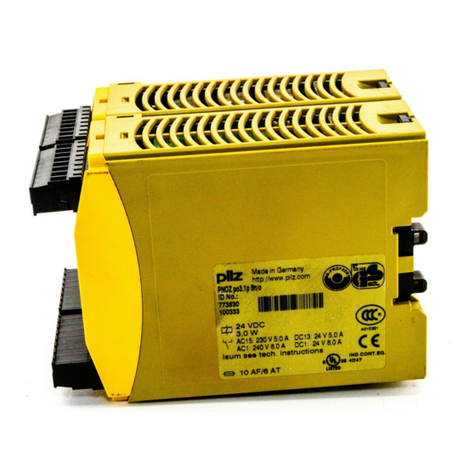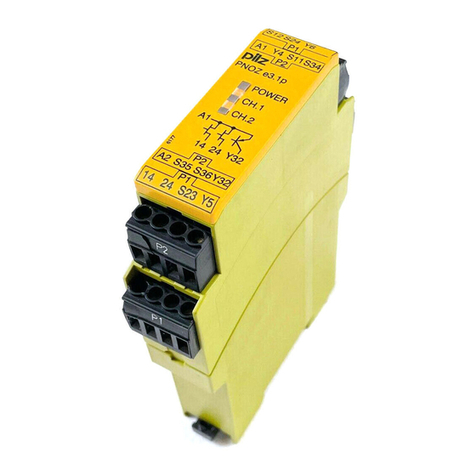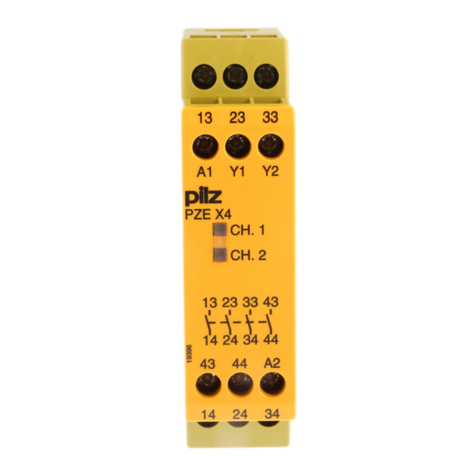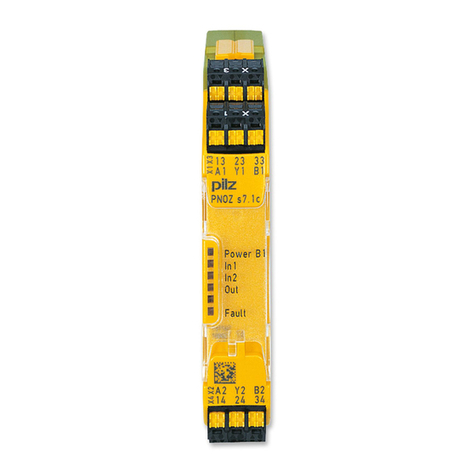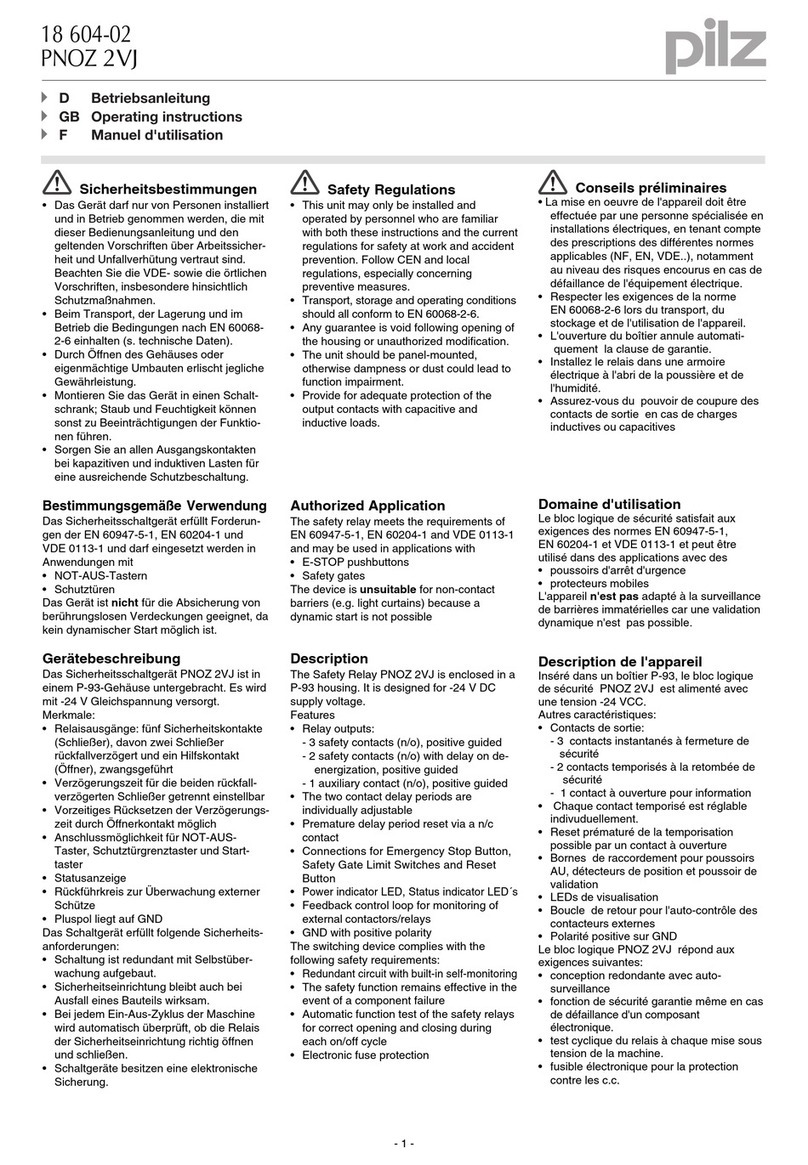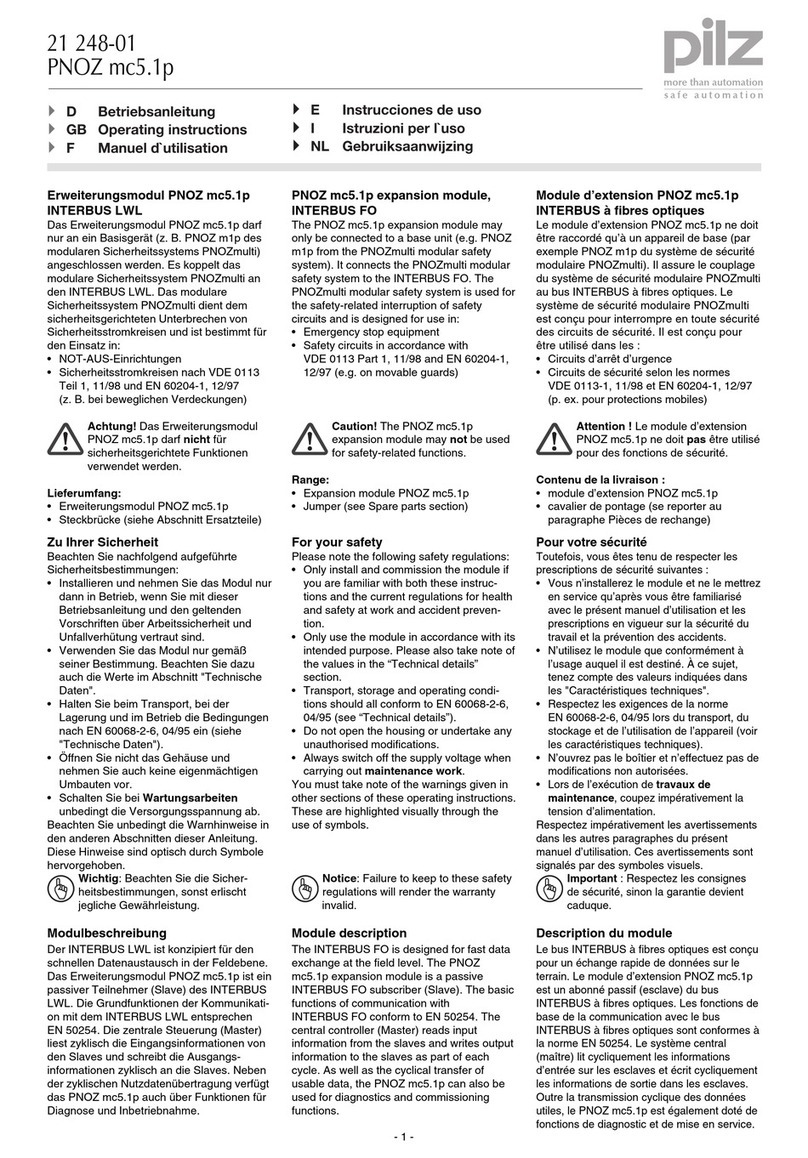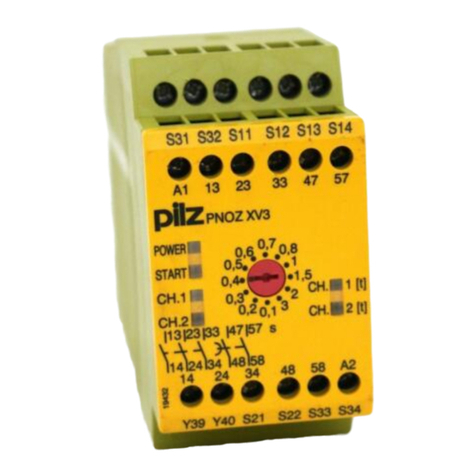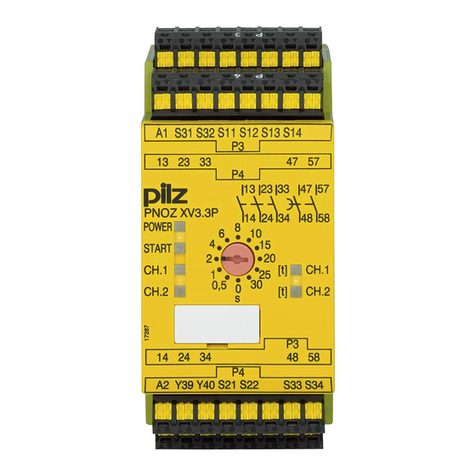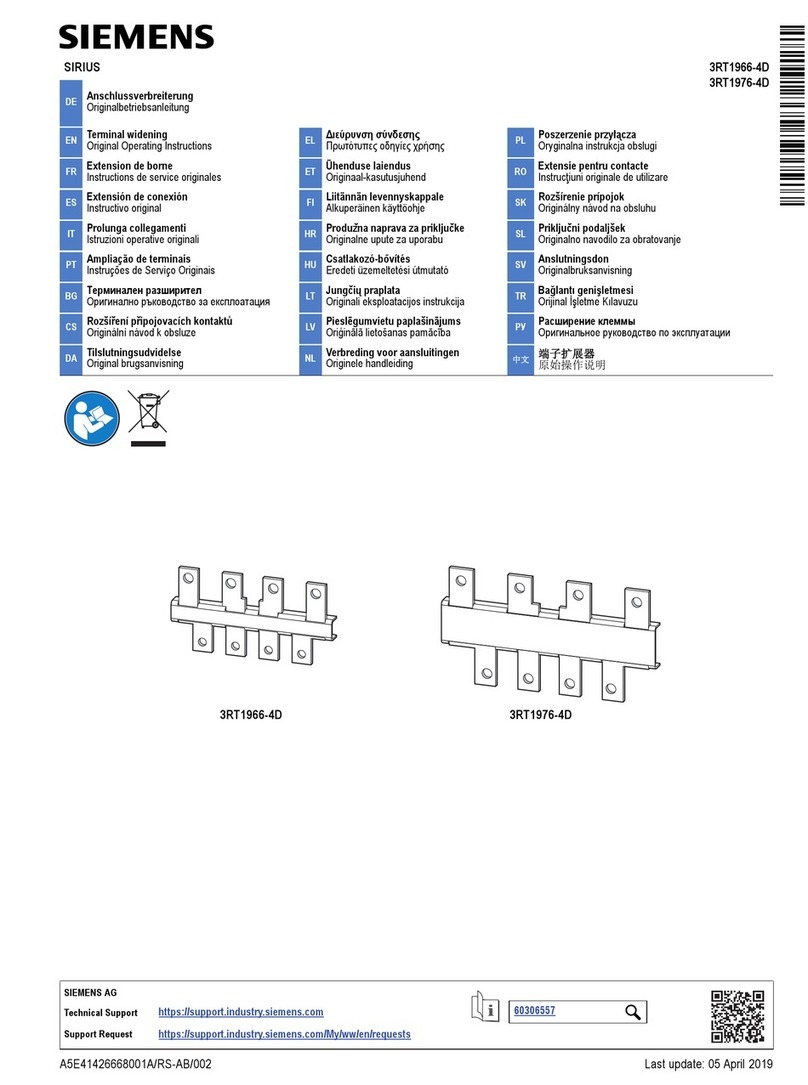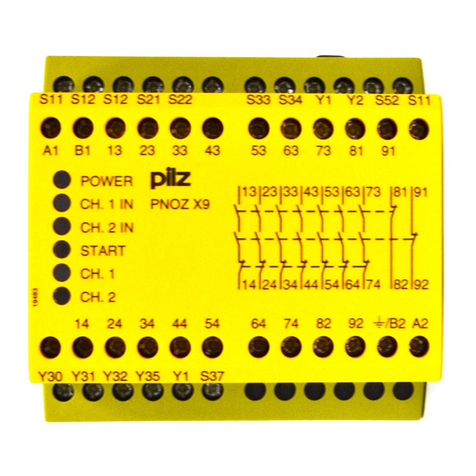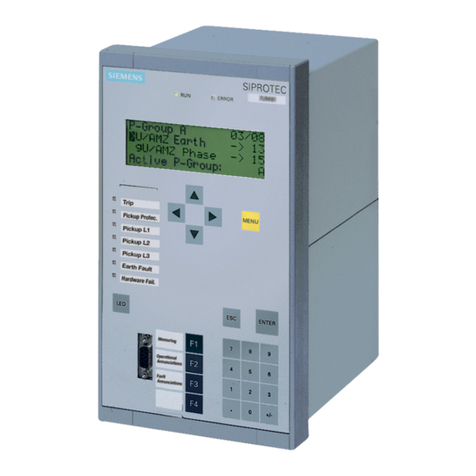
- 7 -
19 045-05
PNOZ X1
4E Instrucciones de uso
4I Istruzioni per l`uso
4NL Gebruiksaan ijzing
Normas de seguridad
• La puesta en marcha del dispositivo debe
ser efectuada por un técnico especializado
en instalaciones eléctricas, teniendo en
cuenta las normativas de las diferentes
normas aplicables (NF, EN, VDE) espe-
cialmente el nivel de riesgo incurrido en
caso de fallo del equipo eléctrico.
• Respetar las exigencias de la norma
EN 60068-2-6 referente al transporte,
almacenaje y utilización del dispositivo (v.
datos técnicos).
• La apertura de la carcasa o manipulación
indebida en el dispositivo anulan cualquier
tipo de garantía.
• Monte el dispositivo en un armario de
distribución; de lo contrario el polvo y la
humedad pueden conducir a un mal fun-
cionamiento del dispositivo.
• Todos los contactos de salida sometidos a
cargas capacitivas e inductivas deben
estar convenientemente protegidos.
Campo de aplicación
El dispositivo sirve para la interrupción
orientada a la seguridad de un circuito de
corriente de seguridad.
El dispositivo de seguridad cumple los
requisitos de las normas EN 60947-5-1, EN
60204-1 e VDE 0113-1 y puede utilizarse en
aplicaciones con
• pulsadores de parada de emergencia
• puertas protectoras
El dispositivo no es apropiado para la protec-
ción de barreras inmateriales, ya que es
imposible un rearme dinámico.
Descripción del dispositivo
El dispositivo de seguridad PNOZ X1 está
alojado en una carcasa S-95. Se puede
hacer funcionar con tensión de corriente
directa de 24 V o con tensión de corriente
alterna de 24 V. No existe ninguna separa-
ción galvánica entre la tensión de alimenta-
ción y el circuito del pulsador.
Características:
• Salidas por relé: 3 contactos de seguridad (NA)
y un contacto auxiliar (NC), con guía forzosa
•
Separación segura de los contactos de
seguridad
13-14, 23-24, 33-34
- de los circuitos de entrada A1-A2
- del circuito de realimentación Y1-Y2
- del contacto auxiliar 41-42
• Opción de conexión para pulsadores de
paro de emergencia
• Indicadores de estado
• Circuito de realimentación para supervi-
sión de contactores externos
El dispositivo cumple los siguientes requisi-
tos de seguridad:
• Concepción redundante con autocontrol.
• El dispositivo de seguridad permanece
activo aún cuando falle un componente.
Norme di sicurezza
• L’apparecchio deve essere installato e
messo in funzione solo da persone a
conoscenza delle presenti istruzioni per
l’uso e delle norme antinfortunistiche e di
sicurezza del lavoro vigenti. Si devono
inoltre rispettare le norme VDE e le norme
locali, in particolare per quanto riguarda gli
interventi di protezione.
• Per il trasporto, l’immagazzinamento ed il
funzionamento, rispettare le norme
EN 60068-2-6 (vedere i dati tecnici).
• In caso di apertura dell’alloggiamento o di
modifiche non autorizzate, non sarà
riconosciuta alcuna garanzia.
• Montare l’apparecchio in un armadio
elettrico, perché la polvere e l’umidità
potrebbero comprometterne il
funzionamento.
• In caso di carichi capacitivi ed induttivi,
assicurare un’adeguata protezione per tutti
i contatti di uscita.
Uso previsto
Il modulo di sicurezza consente l’interruzione
sicura di un circuito di sicurezza.
Il modulo di sicurezza risponde ai requisiti
secondo EN 60947-5-1, EN 60204-1 e
VDE 0113-1 e può essere utilizzato in
applicazioni con
• pulsanti di arresto d’emergenza
• ripari mobili
L’apparecchio non è adatto al controllo delle
barriere fotoelettriche in quanto non è
possibile lo start dinamico.
Descrizione dell’apparecchio
Il modulo di sicurezza PNOZ X1 è inserito in
una custodia S-95. L’apparecchio può
funzionare con tensione continua di 24 V,
oppure con tensione alternata di 24 V. Tra la
tensione di alimentazione ed il circuito del
pulsante non esiste nessuna separazione
galvanica.
Caratteristiche:
• Uscite relè: 3 contatti di sicurezza (NA) ed
un contatto ausiliario (NC), a conduzione
forzata
• Separazione sicura dei contatti di
sicurezza 13-14, 23-24, 33-34
- dai circuiti d'ingresso A1-A2
- dal circuito di retroazione Y1-Y2
- e dal contatto ausiliario 41-42
• Possibilità di collegamento per pulsante di
arresto di emergenza
• LED di visualizzazione di stato
• Retroazione per il controllo dei relè esterni
L’apparecchio elettrico è conforme ai
seguenti requisiti di sicurezza:
• Concezione ridondante con autocontrollo.
• Il dispositivo mantiene la sua funzione di
sicurezza anche in caso di avaria di un
componente.
Veiligheidsvoorschriften
• Het apparaat mag uitsluitend worden
geïnstalleerd en in bedrijf genomen door
personen die vertrouwd zijn met deze
gebruiksaanwijzing en met de geldende
voorschriften op het gebied van
arbeidsveiligheid en ongevallenpreventie.
Neemt u de van toepassing zijnde
Europese richtlijnen en de plaatselijke
voorschriften in acht, in het bijzonder m.b.t.
veiligheidsmaatregelen.
• Bij transport, opslag in bedrijf zijn de
richtlijnen volgens EN 60068-2-6 in acht te
nemen (zie technische gegevens).
• Het openen van de behuizing of het
eigenmachtig veranderen van de
schakeling heeft verlies van de garantie tot
gevolg.
• Monteert u het apparaat in een
schakelkast. Stof en vochtigheid kunnen
anders de werking nadelig beïnvloeden.
• Zorgt u bij capacitieve of inductieve
belasting van de uitgangscontacten voor
adequatecontactbeschermingsmaatregelen.
Toegelaten applicaties
Het veiligheidsrelais dient om een
veiligheidscircuit veilig te onderbreken.
Het veiligheidsrelais voldoet aan de eisen
van EN 60947-5-1, EN 60204-1 en
VDE 0113-1 en mag worden gebruikt in
toepassingen met
• noodstopknoppen
• Hekken
Het apparaat is niet geschikt voor contact-
loze afschermingen, omdat er geen dynami-
sche start mogelijk is.
Apparaatbeschrijving
Het veiligheidsrelais PNOZ X1 is in een
S-95-behuizing ondergebracht. Het kan met
24 V gelijkspanning of met 24 V wissel-
spanning gebruikt worden. Er is geen
galvanische scheiding tussen de voedings-
spanning en het ingangscircuit.
Kenmerken:
• Relaisuitgangen: 3 veiligheidscontacten
(M) en een hulpcontact (V), mechanisch
gedwongen
• Veilige scheiding van de
veiligheidscontacten 13-14, 23-24, 33-34
- van de ingangscircuits A1-A2
- het terugkoppelcircuit Y1-Y2
- en het hulpcontact 41-42
• Aansluitmogelijkheid voor noodstopknoppen
• Status-LED’s
• Terugkoppelcircuit voor de bewaking van
externe magneetschakelaars
Het relais voldoet aan de volgende
veiligheidseisen:
• De schakeling is redundant met zelfcon-
trole opgebouwd.
• Ook bij uitvallen van een component blijft
de veiligheidsschakeling werken.

